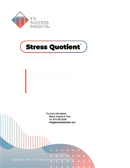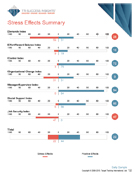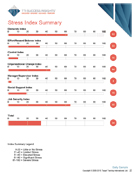| | |
| |
TTI Assessments & Related Tools
Stress Quotient - Stress Assessment
Stress Quotient Reports - Individual & Group
Workplace stress can have a profound effect on productivity and engagement in the organization.
When stress factors are coupled with potentially ineffective management, stress can become a problem that extends to the entire
department or company.
Identifying signs of stress within the organization is the first step in designing a strategy to address the issue.
 Any job can have stressful elements, even if you love what you do.
Some stress at work is normal, however excessive stress can obstruct productivity and impact physical and emotional health.
Any job can have stressful elements, even if you love what you do.
Some stress at work is normal, however excessive stress can obstruct productivity and impact physical and emotional health.
An individual's ability to deal with it can mean the difference between success and failure. There are situations in the work
environment that can not be controlled. But that does not mean the individual is powerless even when stuck in a problematic
situation.
Finding ways to manage stress is not about making huge changes or rethinking career ambitions, but rather about focusing on
the things that are within the person's control.
Stress at work can be defined as the harmful physical and emotional responses that occur when the requirements of the job do
not match the capabilities, resources, or needs of the worker. Stress at work can lead to poor health and even injury.
The concept of stress at work is often confused with a challenge, but these concepts are not the same.
Being challenged can energize us psychologically and physically, and it can motivate us to learn new skills and leads to mastery
of our jobs. When a challenge is met, we feel energized and satisfied.
Thus, challenge is an important ingredient to be healthy and productive at work. A healthy work environment is one where the
pressures on employees are relevant to their abilities and resources, to the amount of control they have over their work, and the
support they receive.
 Stress Factor Indexs
Stress Factor Indexs
Demand
While employees need challenging tasks to maintain their engagement, motivation, and to develop new skills, it is important
that demands do not exceed their ability to cope. Workplace stress tends to build as demands and responsibilities increase.
Stress can be directly tied to poorly designed jobs, excessive workloads, and, talents and skills not matching the work.
The goal is to have a balance between demands and time.
Effort / Reward
Having purpose or job satisfaction is an important factor in any job. High effort without satisfying one's need for rewards can
lead to workplace stress. Rewards come in many forms: recognition, helping others, gaining knowledge,personal growth,
principles or compensation. High effort in the workplace is essential but must be matched by the reward that the individual desires.
Workplace stress arises when the employee feels a significant disconnect between their needs and how they are rewarded.
Control
A feeling of powerlessness is a universal cause of job stress. The individual will alter or avoid the situation because he/she feeld
nothing can be done. Common sources of stress at work include complaints of too much responsibility with too little authority,
being involved, not being heard, and no one understanding what you really do. Workplace stress increases as one's degree of
control decreases. The goal is to have a balance between responsibilities and personal control.
Organizational Change
Organizational change affects people differently. While some people welcome it, others will become apprehensive and stressed at
the mere mention of change. Organizational change can be defined as any change in people, structure, technology or procedures.
Organizational change can vary in degree and direction produce uncertainty, and, can initiate both stress and opportunities.
Manager / Supervisor
Common reasons given for stress at work can include lack of support from manager(s) or supervisor(s).
Most working people do not realize that stress is a vital part of their job. That is why, when a boss places reasonable demands
on the individual (like giving a deadline agreed on by both), it can actually help get the job done more efficiently.
However, the boss can do things that go beyond normal pressure or challenges. This causes stress.
Social Support
A lack of support from colleagues and managers can lead to workplace stress. A supportive environment is one where managers
provide clear and consistent information and co-workers stand ready to assist when needed. An environment that promotes positive
working relationships and addresses unacceptable behavior promotes productivity and employee engagement.
Job Security
People worry about many aspects of their jobs, but most of the fear comes from job security. Job insecurity comes from the fear of job
loss and the associated unemployment implications. Stress can also originate from a lack of advancement or being promoted too
slowly. People also can have a concern with being promoted too quickly to be successful in the job.
 Symptoms and Effects
Symptoms and Effects
Stress Symptoms
This section is critical to understanding overall stress and how it could affect you. This section looks at physical, emotional, cognitive,
and behavioral symptoms of stress. Each individual handles stress differently. Stress can be affected by outside-the-job factors that
can increase the likelihood of negative effects.
Stress Effects Summary
The graphics in the section show the degree of balance between stress effects and positive effects. While the stress effects scores
parallel the stress index scores, they are not identical. To get an accurate view of how activities can cause stress or create a positive
effect, we apply a different scoring model to the same set of questions. This section can give you a perspective to the degree of
potential stress a person might have.
Stress Effects Analysis
The Stress Effects Radar graphic offers a quick visual overview of the stress effects and positive effects.
Stress Symptoms
Stress Symptoms Index
Stress is a normal part of life. Stress can be the body's reaction to change that requires an adjustment or response.
Many events that happen to and around a person put stress on his/her body. The body reacts to changes with physical, mental and
emotional responses. Stress becomes negative when a person faces continuous challenges without relief or relaxation between challenges.
View Stress Quotient Individual report sample
View Stress Quotient Group report sample
View How to use Stress Quotient results
View Stress Quotient brochure
Please contact us for more information and pricing.
OTHER ASSESSMENTS
View information about all of the Online Assessments / Reports
Return to TTI assessments & training tools main page.
These assessments are not a measure of intelligence, values, skills, experience, education or training.
Facilitator material, Games
Role Exercise Games
Behaviors / DISC options
12 Driving Forces / Motivators / Attitudes options
Combined Behaviors / DISC + Motivators
Sales / Selling related
Emotional Quotient - Emotional Intelligence
Technical Reports
TTI DISC / Behaviors Technical report
TTI Motivators Technical report
TTI DNA Competencies Technical report
TTI Combined Technical reports
Emotional Quotient Technical report
Return to TTI assessments & training tools main page.
| |
|
 |
Sunday, December 21, 2025



















































|
|
|
|
|
|
|





































































































































































